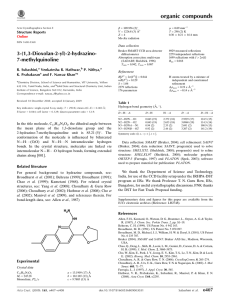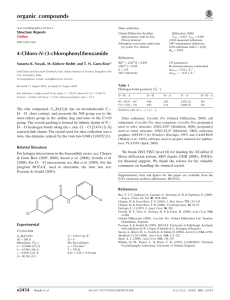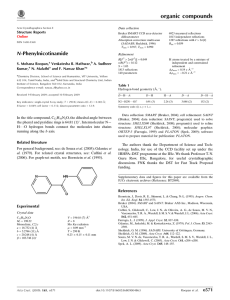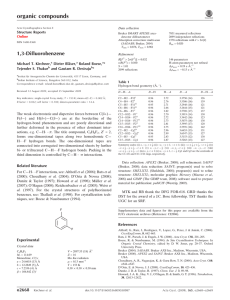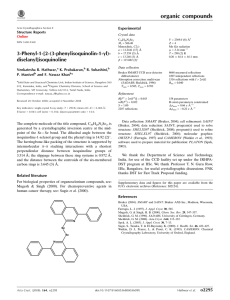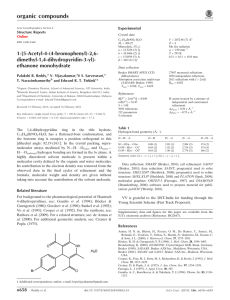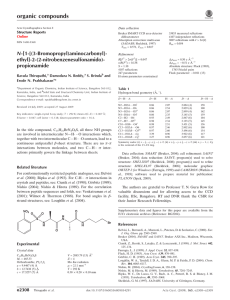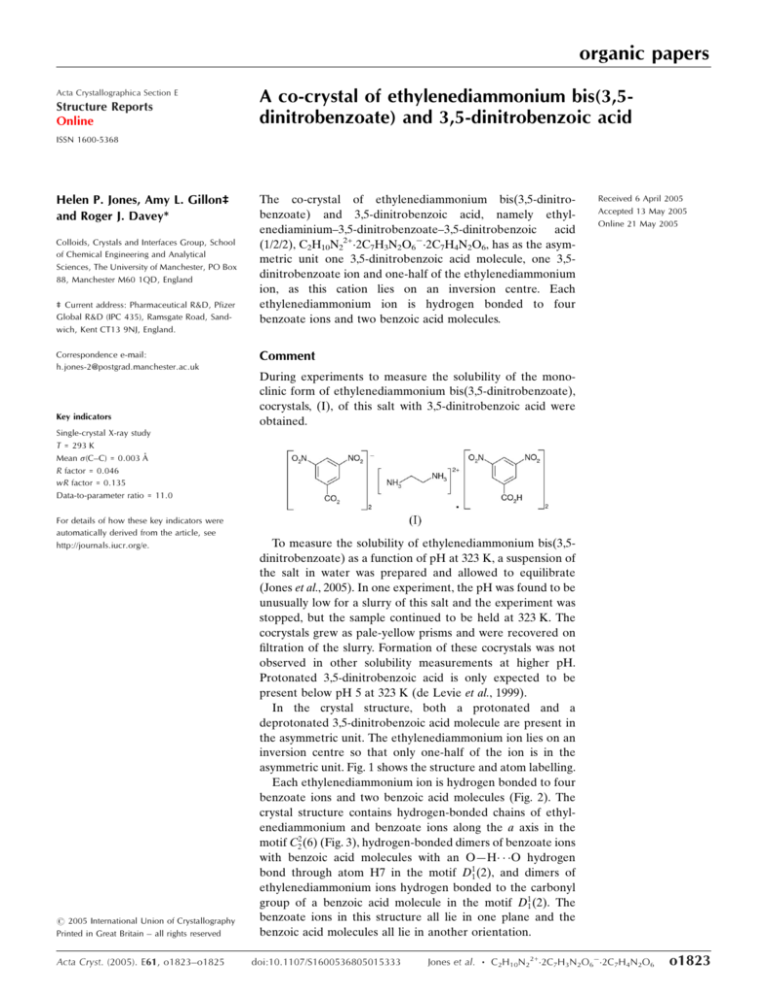
organic papers
Acta Crystallographica Section E
Structure Reports
Online
A co-crystal of ethylenediammonium bis(3,5dinitrobenzoate) and 3,5-dinitrobenzoic acid
ISSN 1600-5368
Helen P. Jones, Amy L. Gillon‡
and Roger J. Davey*
Colloids, Crystals and Interfaces Group, School
of Chemical Engineering and Analytical
Sciences, The University of Manchester, PO Box
88, Manchester M60 1QD, England
‡ Current address: Pharmaceutical R&D, Pfizer
Global R&D (IPC 435), Ramsgate Road, Sandwich, Kent CT13 9NJ, England.
Correspondence e-mail:
h.jones-2@postgrad.manchester.ac.uk
Key indicators
The co-crystal of ethylenediammonium bis(3,5-dinitrobenzoate) and 3,5-dinitrobenzoic acid, namely ethylenediaminium–3,5-dinitrobenzoate–3,5-dinitrobenzoic acid
(1/2/2), C2H10N22+2C7H3N2O62C7H4N2O6, has as the asymmetric unit one 3,5-dinitrobenzoic acid molecule, one 3,5dinitrobenzoate ion and one-half of the ethylenediammonium
ion, as this cation lies on an inversion centre. Each
ethylenediammonium ion is hydrogen bonded to four
benzoate ions and two benzoic acid molecules.
Received 6 April 2005
Accepted 13 May 2005
Online 21 May 2005
Comment
During experiments to measure the solubility of the monoclinic form of ethylenediammonium bis(3,5-dinitrobenzoate),
cocrystals, (I), of this salt with 3,5-dinitrobenzoic acid were
obtained.
Single-crystal X-ray study
T = 293 K
Mean (C–C) = 0.003 Å
R factor = 0.046
wR factor = 0.135
Data-to-parameter ratio = 11.0
For details of how these key indicators were
automatically derived from the article, see
http://journals.iucr.org/e.
# 2005 International Union of Crystallography
Printed in Great Britain – all rights reserved
Acta Cryst. (2005). E61, o1823–o1825
To measure the solubility of ethylenediammonium bis(3,5dinitrobenzoate) as a function of pH at 323 K, a suspension of
the salt in water was prepared and allowed to equilibrate
(Jones et al., 2005). In one experiment, the pH was found to be
unusually low for a slurry of this salt and the experiment was
stopped, but the sample continued to be held at 323 K. The
cocrystals grew as pale-yellow prisms and were recovered on
filtration of the slurry. Formation of these cocrystals was not
observed in other solubility measurements at higher pH.
Protonated 3,5-dinitrobenzoic acid is only expected to be
present below pH 5 at 323 K (de Levie et al., 1999).
In the crystal structure, both a protonated and a
deprotonated 3,5-dinitrobenzoic acid molecule are present in
the asymmetric unit. The ethylenediammonium ion lies on an
inversion centre so that only one-half of the ion is in the
asymmetric unit. Fig. 1 shows the structure and atom labelling.
Each ethylenediammonium ion is hydrogen bonded to four
benzoate ions and two benzoic acid molecules (Fig. 2). The
crystal structure contains hydrogen-bonded chains of ethylenediammonium and benzoate ions along the a axis in the
motif C22 (6) (Fig. 3), hydrogen-bonded dimers of benzoate ions
with benzoic acid molecules with an O—H O hydrogen
bond through atom H7 in the motif D11 (2), and dimers of
ethylenediammonium ions hydrogen bonded to the carbonyl
group of a benzoic acid molecule in the motif D11 (2). The
benzoate ions in this structure all lie in one plane and the
benzoic acid molecules all lie in another orientation.
doi:10.1107/S1600536805015333
Jones et al.
C2H10N22+2C7H3N2O62C7H4N2O6
o1823
organic papers
Figure 1
View of the asymmetric unit of (I), including the whole ethylenediaminium ion, which is on an inversion centre. Displacement
ellipsoids are drawn at the 50% probability level. [Symmetry code: (i)
x, y, z.]
Figure 2
Hydrogen bonding (dashed lines) between the ethylenediaminium and
3,5-dinitrobenzoate ions and the 3,5-dinitrobenzoic acid molecules.
Experimental
Monoclinic ethylenediaminium bis(3,5-dinitrobenzoate) was
prepared by precipitation from a mixture of solutions of ethylenediamine (0.0145 mol) and 3,5-dinitrobenzoic acid (0.029 mol;
supplied by Sigma–Aldrich, 99%) in ethanol (50 ml). An excess
of monoclinic ethylenediammonium bis(3,5-dinitrobenzoate)
(0.0145 mol) was suspended in water (40 ml) at 323 K with stirring.
The solution pH was recorded as 3.79. After 20 h, stirring was
stopped and the suspension was held at 323 K for 5 d. The suspension
was filtered and pale-yellow prisms were observed in the powder of
the monoclinic ethylenediammonium bis(3,5-dinitrobenzoate).
Crystal data
C2H10N2 2þ 2C7H3N2O6 2C7H4N2O6
Mr = 908.6
Triclinic, P1
a = 7.0452 (3) Å
b = 11.2345 (4) Å
c = 11.7627 (5) Å
= 91.838 (2)
= 96.230 (2)
= 98.710 (1)
V = 913.72 (6) Å3
Z=1
Dx = 1.651 Mg m3
Mo K radiation
Cell parameters from 5294
reflections
= 1.0–25.0
= 0.15 mm1
T = 293 (2) K
Prism, pale yellow
0.3 0.2 0.1 mm
Data collection
Nonius KappaCCD diffractometer
Thick-slice ’ and ! scans to fill
asymmetric unit
Absorption correction: multi-scan
(Blessing, 1995)
Tmin = 0.916, Tmax = 0.986
8852 measured reflections
3241 independent reflections
2256 reflections with I > 2(I)
Rint = 0.046
max = 25.2
h = 8 ! 8
k = 13 ! 13
l = 14 ! 12
Figure 3
Unit cell contents, viewed along the c axis, showing hydrogen-bonded
chains (dashed lines) along the a axis.
Table 1
Refinement
Hydrogen-bond geometry (Å, ).
2
Refinement on F
R[F 2 > 2(F 2)] = 0.046
wR(F 2) = 0.136
S = 1.01
3241 reflections
294 parameters
H atoms treated by a mixture of
independent and constrained
refinement
o1824
Jones et al.
2
(Fo2)
2
w = 1/[
+ (0.0776P) ]
where P = (Fo2 + 2Fc2)/3
(/)max < 0.001
max = 0.20 e Å3
min = 0.21 e Å3
Extinction correction: SHELXL97
Extinction coefficient: 0.016 (4)
C2H10N22+2C7H3N2O62C7H4N2O6
D—H A
D—H
H A
D A
D—H A
O7—H7 O1
N5—H5A O2
N5—H5B O8ii
N5—H5C O1ii
0.83 (1)
0.89
0.89
0.89
1.68 (1)
1.88
2.17
2.02
2.507
2.732
2.820
2.899
173 (4)
161
129
170
(2)
(3)
(3)
(3)
Symmetry code: (ii) x þ 1; y; z.
Acta Cryst. (2005). E61, o1823--o1825
organic papers
All H atoms attached to C and N atoms were fixed using a riding
model, with C—H distances 0.93 Å (CArH) and 0.97 Å (CH2), and
N—H distances 0.89 Å. The Uiso(H) values were set equal to 1.2Ueq
of the carrier atom for these H atoms. The hydroxy H atom was
located in a Fourier difference map and the coordinates were refined
with the O—H bond distance restrained to 0.82 (1) Å.
Data collection: COLLECT (Nonius, 2000); cell refinement: HKL
SCALEPACK (Otwinowski & Minor, 1997); data reduction: HKL
DENZO (Otwinowski & Minor, 1997) and SCALEPACK;
program(s) used to solve structure: SHELXS97 (Sheldrick, 1997);
program(s) used to refine structure: SHELXL97 (Sheldrick, 1997);
molecular graphics: ORTEP-3 for Windows (Farrugia, 1997); software used to prepare material for publication: WinGX (Farrugia,
1999).
Acta Cryst. (2005). E61, o1823–o1825
The authors thank Sanofi–Aventis Ltd for funding.
References
Blessing, R. H. (1995). Acta Cryst. A51, 33–38.
Farrugia, L. J. (1997). J. Appl. Cryst. 30, 565.
Farrugia, L. J. (1999). J. Appl. Cryst. 32, 837–838.
Jones, H. P., Davey, R. J. & Cox, B. G. (2005). J. Phys. Chem. B, 109, 5273–5278.
Levie, R. de (1999). Aqueous Acid–Base Equilibria and Titrations. New York:
Oxford University Press.
Nonius (2000). COLLECT. Nonius BV, Delft, The Netherlands.
Otwinowski, Z. & Minor, W. (1997). Methods in Enzymology, Vol. 276,
Macromolecular Crystallography, Part A, edited by C. W. Carter Jr & R. M.
Sweet, pp. 307–326. New York: Academic Press.
Sheldrick, G. M. (1997). SHELXS97 and SHELXL97. University of
Göttingen, Germany.
Jones et al.
C2H10N22+2C7H3N2O62C7H4N2O6
o1825
supporting information
supporting information
Acta Cryst. (2005). E61, o1823–o1825
[doi:10.1107/S1600536805015333]
A co-crystal of ethylenediammonium bis(3,5-dinitrobenzoate) and 3,5-dinitrobenzoic acid
Helen P. Jones, Amy L. Gillon and Roger J. Davey
S1. Comment
During experiments to measure the solubility of the monoclinic form of ethylenediaminium bis(3,5-dinitrobenzoate),
cocrystals, (I), of this salt with 3,5-dinitrobenzoic acid were obtained.
To measure the solubility of ethylenediaminium bis(3,5-dinitrobenzoate) as a function of pH at 323 K, a suspension of
the salt in water was prepared and allowed to equilibrate (Jones et al., 2005). In one experiment, the pH was found to be
unusually low for a slurry of this salt and the experiment was stopped, but the sample continued to be held at 323 K. The
cocrystals grew as pale-yellow prisms and were recovered on filtration of the slurry. Formation of these co-crystals was
not observed in other solubility measurements at higher pH. Protonated 3,5-dinitrobenzoic acid is only expected to be
present below pH 5 at 323 K (de Levie et al., 1999).
In the crystal structure, both a protonated and a deprotonated 3,5-dinitrobenzoic acid molecule are present in the
asymmetric unit. The ethylenediaminium ion lies on an inversion centre so that only one-half of the ion is in the
asymmetric unit. Fig. 1 shows the structure and atom labelling.
Each ethylenediaminium ion is hydrogen bonded to four benzoate ions and two benzoic acid molecules (Fig. 2). The
crystal structure contains hydrogen-bonded chains of ethylenediaminium and benzoate ions along the a axis in the motif
C22(6) (Fig. 3), hydrogen-bonded dimers of benzoate ions with benzoic acid molecules with an O—H···O hydrogen bond
through atom H7 in the motif D11(2), and dimers of ethylenediaminium ions hydrogen bonded to the carbonyl group of a
benzoic acid molecule in the motif D11(2). The benzoate ions in this structure all lie in one plane and the benzoic acid
molecules all lie in another orientation.
S2. Experimental
Monoclinic ethylenediaminium bis(3,5-dinitrobenzoate) was prepared by precipitation from a mixture of solutions of
ethylenediamine and 3,5-dinitrobenzoic acid (supplied by Sigma–Aldrich, 99%) in ethanol. An excess of monoclinic
ethylenediaminium bis(3,5-dinitrobenzoate) was suspended in water at 323 K with stirring. The solution pH was recorded
as 3.79. After 20 h, stirring was stopped and the supspension was held at 323 Kfor 5 d. The suspension was filtered and
pale-yellow prisms were observed in the powder of the monoclinic ethylenediaminium bis(3,5-dinitrobenzoate).
S3. Refinement
All H atoms attached to C and N atoms were fixed using a riding model, with C—H distances 0.93 Å (CArH) and 0.97 Å
(CH2), and N—H distances 0.89 Å. The Uiso(H) values were set equal to 1.2Ueq of the carrier atom for these H atoms. The
hydroxy H atom was located in a Fourier difference map and the coordinates were refined with the O—H bond distance
restrained to 0.82 (1) Å.
Acta Cryst. (2005). E61, o1823–o1825
sup-1
supporting information
Figure 1
View of the asymmetric unit of (I), showing the whole ethylenediaminium ion, which is on an inversion centre.
Displacement ellipsoids are drawn at the 50% probability level. [Symmetry code: (i) −x, −y, −z.]
Figure 2
Hydrogen bonding between the ethylenediaminium and 3,5-dinitrobenzoate ions and the 3,5-dinitrobenzoic acid
molecules.
Acta Cryst. (2005). E61, o1823–o1825
sup-2
supporting information
Figure 3
Unit-cell contents viewed along the c axis, showing hydrogen-bonded chains along the a axis.
ethylenediaminium–3,5-dinitrobenzoate–3,5-dinitrobenzoic acid (1/2/2), C2H10N22+·2C7H3N2O6−·2C7H4N2O6
Crystal data
0.5C2H10N22+·C7H3N2O6−·C7H4N2O6
Mr = 454.3
Triclinic, P1
Hall symbol: -P 1
a = 7.0452 (3) Å
b = 11.2345 (4) Å
c = 11.7627 (5) Å
α = 91.838 (2)°
β = 96.230 (2)°
γ = 98.710 (1)°
V = 913.72 (6) Å3
Acta Cryst. (2005). E61, o1823–o1825
Z=2
F(000) = 466
Dx = 1.651 Mg m−3
Mo Kα radiation, λ = 0.71073 Å
Cell parameters from 5294 reflections
θ = 1.0–25.0°
µ = 0.15 mm−1
T = 293 K
Prism, pale yellow
0.3 × 0.2 × 0.1 mm
sup-3
supporting information
Data collection
Nonius KappaCCD
diffractometer
Radiation source: Enraf–Nonius FR590
Graphite monochromator
φ or ω scans?
Absorption correction: multi-scan
(Blessing, 1995)
Tmin = 0.916, Tmax = 0.986
8852 measured reflections
3241 independent reflections
2256 reflections with I > 2σ(I)
Rint = 0.046
θmax = 25.2°, θmin = 2.5°
h = −8→8
k = −13→13
l = −14→12
Refinement
Refinement on F2
Least-squares matrix: full
R[F2 > 2σ(F2)] = 0.046
wR(F2) = 0.136
S = 1.01
3241 reflections
294 parameters
1 restraint
Primary atom site location: structure-invariant
direct methods
Secondary atom site location: difference Fourier
map
Hydrogen site location: inferred from
neighbouring sites
H atoms treated by a mixture of independent
and constrained refinement
w = 1/[σ2(Fo2) + (0.0776P)2]
where P = (Fo2 + 2Fc2)/3
(Δ/σ)max < 0.001
Δρmax = 0.20 e Å−3
Δρmin = −0.21 e Å−3
Extinction correction: SHELXL97,
Fc*=kFc[1+0.001xFc2λ3/sin(2θ)]-1/4
Extinction coefficient: 0.016 (4)
Special details
Experimental. Solution pH was measured using an Accumet Basic AB15 pH meter with an Accumet glass calomel pH
electrode and an ATC probe to compensate for temperature changes.
Geometry. All e.s.d.'s (except the e.s.d. in the dihedral angle between two l.s. planes) are estimated using the full
covariance matrix. The cell e.s.d.'s are taken into account individually in the estimation of e.s.d.'s in distances, angles and
torsion angles; correlations between e.s.d.'s in cell parameters are only used when they are defined by crystal symmetry.
An approximate (isotropic) treatment of cell e.s.d.'s is used for estimating e.s.d.'s involving l.s. planes.
Refinement. Refinement of F2 against ALL reflections. The weighted R-factor wR and goodness of fit S are based on F2,
conventional R-factors R are based on F, with F set to zero for negative F2. The threshold expression of F2 > σ(F2) is used
only for calculating R-factors(gt) etc. and is not relevant to the choice of reflections for refinement. R-factors based on F2
are statistically about twice as large as those based on F, and R- factors based on ALL data will be even larger.
Fractional atomic coordinates and isotropic or equivalent isotropic displacement parameters (Å2)
O1
O2
O3
O4
O5
O6
O7
O8
O9
O10
O11
O12
N1
x
y
z
Uiso*/Ueq
0.3739 (2)
0.6632 (3)
0.7755 (3)
0.6306 (3)
0.0621 (3)
−0.0276 (3)
0.5246 (3)
0.2299 (3)
0.1253 (3)
0.3350 (3)
0.9653 (3)
1.0348 (3)
0.6524 (3)
0.04198 (13)
−0.01493 (13)
−0.38263 (14)
−0.42815 (15)
−0.26099 (18)
−0.12294 (18)
0.24130 (15)
0.26663 (15)
0.66997 (17)
0.82267 (16)
0.76827 (14)
0.58912 (16)
−0.37047 (16)
0.75723 (14)
0.76044 (15)
0.94862 (14)
1.09778 (14)
1.15926 (16)
1.05344 (18)
0.69250 (16)
0.62078 (17)
0.50938 (18)
0.5700 (2)
0.73491 (15)
0.75615 (16)
1.01241 (16)
0.0508 (4)
0.0553 (5)
0.0596 (5)
0.0648 (5)
0.0718 (6)
0.0724 (6)
0.0590 (5)
0.0680 (5)
0.0741 (6)
0.0889 (7)
0.0618 (5)
0.0638 (5)
0.0475 (5)
Acta Cryst. (2005). E61, o1823–o1825
sup-4
supporting information
N2
N3
N4
N5
H5A
H5B
H5C
C1
C2
H2
C3
C4
H4
C5
C6
H6
C7
C8
C9
H9
C10
C11
H11
C12
C13
H13
C14
C15
H15A
H15B
H7
0.0813 (3)
0.2801 (3)
0.9221 (3)
0.9846 (3)
0.8995
0.9863
1.1016
0.4465 (3)
0.5689 (3)
0.681
0.5229 (3)
0.3618 (3)
0.332
0.2463 (3)
0.2833 (3)
0.1998
0.5006 (3)
0.4724 (3)
0.3459 (3)
0.2179
0.4134 (3)
0.5990 (3)
0.6405
0.7218 (3)
0.6631 (3)
0.7496
0.3964 (4)
0.9287 (3)
0.8006
0.9249
0.469 (5)
−0.19415 (18)
0.71433 (18)
0.65764 (17)
0.05043 (17)
0.0265
0.1285
0.0382
−0.11491 (17)
−0.19825 (17)
−0.1975
−0.28228 (18)
−0.28528 (19)
−0.3427
−0.19926 (18)
−0.11494 (18)
−0.0598
−0.02253 (17)
0.43735 (17)
0.51274 (18)
0.482
0.63433 (18)
0.68435 (18)
0.7669
0.60689 (18)
0.48361 (18)
0.4332
0.30531 (19)
−0.01948 (18)
−0.007
−0.1048
0.1743 (18)
1.07990 (18)
0.55839 (17)
0.72899 (16)
0.65242 (17)
0.7009
0.6413
0.6816
0.87777 (17)
0.90467 (17)
0.8694
0.98423 (17)
1.04054 (18)
1.0937
1.01452 (17)
0.93258 (18)
0.9151
0.79096 (18)
0.65036 (16)
0.60851 (17)
0.5824
0.60626 (17)
0.64562 (17)
0.6452
0.68589 (17)
0.68852 (17)
0.7152
0.65396 (18)
0.54167 (18)
0.5102
0.5538
0.709 (3)
0.0520 (5)
0.0537 (5)
0.0455 (5)
0.0571 (6)
0.069*
0.069*
0.069*
0.0371 (5)
0.0394 (5)
0.047*
0.0403 (5)
0.0433 (6)
0.052*
0.0400 (5)
0.0395 (5)
0.047*
0.0403 (5)
0.0368 (5)
0.0391 (5)
0.047*
0.0404 (5)
0.0400 (5)
0.048*
0.0375 (5)
0.0382 (5)
0.046*
0.0432 (6)
0.0421 (5)
0.051*
0.051*
0.123 (14)*
Atomic displacement parameters (Å2)
O1
O2
O3
O4
O5
O6
O7
O8
O9
O10
O11
O12
N1
U11
U22
U33
U12
U13
U23
0.0486 (11)
0.0492 (11)
0.0678 (13)
0.0793 (14)
0.0613 (13)
0.0568 (13)
0.0558 (12)
0.0566 (13)
0.0581 (13)
0.0967 (18)
0.0587 (12)
0.0422 (11)
0.0557 (14)
0.0417 (8)
0.0509 (9)
0.0629 (11)
0.0686 (11)
0.0999 (14)
0.0806 (13)
0.0416 (9)
0.0474 (9)
0.0767 (13)
0.0460 (12)
0.0467 (10)
0.0674 (11)
0.0459 (11)
0.0650 (10)
0.0700 (11)
0.0573 (11)
0.0535 (11)
0.0587 (12)
0.0898 (15)
0.0771 (12)
0.0902 (14)
0.0840 (14)
0.1208 (19)
0.0724 (12)
0.0818 (13)
0.0427 (11)
0.0101 (8)
0.0061 (8)
0.0291 (9)
0.0243 (10)
0.0094 (10)
0.0248 (10)
0.0025 (8)
−0.0091 (9)
0.0186 (10)
0.0235 (11)
−0.0097 (8)
0.0111 (9)
0.0130 (9)
0.0127 (8)
0.0237 (9)
0.0207 (10)
0.0148 (9)
0.0249 (10)
0.0301 (11)
0.0011 (9)
−0.0146 (10)
−0.0189 (11)
−0.0197 (14)
−0.0015 (9)
0.0032 (9)
0.0059 (10)
0.0141 (7)
0.0159 (8)
0.0089 (8)
0.0255 (8)
0.0247 (10)
0.0154 (10)
0.0145 (8)
0.0145 (8)
0.0052 (10)
0.0052 (10)
0.0027 (8)
0.0066 (9)
0.0060 (8)
Acta Cryst. (2005). E61, o1823–o1825
sup-5
supporting information
N2
N3
N4
N5
C1
C2
C3
C4
C5
C6
C7
C8
C9
C10
C11
C12
C13
C14
C15
0.0418 (13)
0.0579 (15)
0.0413 (12)
0.0560 (14)
0.0410 (13)
0.0416 (14)
0.0445 (14)
0.0466 (15)
0.0350 (13)
0.0379 (13)
0.0431 (15)
0.0415 (14)
0.0379 (13)
0.0472 (14)
0.0482 (15)
0.0387 (13)
0.0444 (14)
0.0467 (16)
0.0437 (14)
0.0608 (13)
0.0534 (13)
0.0497 (12)
0.0594 (12)
0.0337 (10)
0.0407 (11)
0.0409 (11)
0.0454 (12)
0.0474 (12)
0.0394 (11)
0.0329 (11)
0.0384 (11)
0.0452 (12)
0.0430 (12)
0.0356 (11)
0.0415 (11)
0.0393 (11)
0.0424 (12)
0.0389 (11)
0.0524 (13)
0.0521 (12)
0.0449 (11)
0.0518 (12)
0.0355 (11)
0.0364 (12)
0.0361 (12)
0.0368 (12)
0.0369 (12)
0.0407 (12)
0.0438 (13)
0.0298 (11)
0.0328 (11)
0.0327 (11)
0.0361 (12)
0.0316 (11)
0.0320 (11)
0.0385 (12)
0.0434 (12)
0.0015 (10)
0.0192 (11)
0.0020 (10)
−0.0124 (10)
0.0020 (9)
0.0055 (10)
0.0086 (10)
0.0013 (10)
0.0012 (10)
0.0051 (9)
−0.0003 (10)
0.0020 (9)
0.0020 (10)
0.0117 (10)
0.0048 (10)
0.0011 (9)
0.0069 (10)
0.0002 (11)
0.0004 (10)
0.0105 (10)
0.0023 (11)
0.0083 (9)
0.0190 (10)
0.0051 (9)
0.0084 (10)
0.0046 (10)
0.0072 (10)
0.0093 (10)
0.0040 (10)
0.0092 (11)
0.0066 (9)
0.0041 (9)
0.0055 (10)
0.0069 (10)
0.0077 (9)
0.0075 (10)
0.0041 (11)
0.0103 (10)
0.0023 (10)
0.0025 (9)
0.0036 (8)
−0.0014 (9)
−0.0013 (8)
−0.0011 (9)
0.0020 (9)
0.0036 (9)
−0.0024 (9)
−0.0014 (8)
−0.0014 (9)
0.0032 (8)
−0.0004 (8)
0.0020 (8)
0.0015 (8)
0.0020 (8)
0.0039 (8)
0.0059 (9)
0.0060 (9)
Geometric parameters (Å, º)
O1—C7
O2—C7
O3—N1
O4—N1
O5—N2
O6—N2
O7—C14
O7—H7
O8—C14
O9—N3
O10—N3
O11—N4
O12—N4
N1—C3
N2—C5
N3—C10
N4—C12
N5—C15
N5—H5A
N5—H5B
N5—H5C
C1—C6
1.271 (3)
1.229 (3)
1.226 (2)
1.224 (2)
1.223 (3)
1.215 (3)
1.292 (3)
0.833 (10)
1.205 (3)
1.204 (3)
1.219 (3)
1.232 (2)
1.213 (2)
1.468 (3)
1.469 (3)
1.477 (3)
1.468 (3)
1.483 (3)
0.89
0.89
0.89
1.377 (3)
C1—C2
C1—C7
C2—C3
C2—H2
C3—C4
C4—C5
C4—H4
C5—C6
C6—H6
C8—C9
C8—C13
C8—C14
C9—C10
C9—H9
C10—C11
C11—C12
C11—H11
C12—C13
C13—H13
C15—C15i
C15—H15A
C15—H15B
1.388 (3)
1.516 (3)
1.379 (3)
0.93
1.371 (3)
1.376 (3)
0.93
1.390 (3)
0.93
1.384 (3)
1.386 (3)
1.502 (3)
1.379 (3)
0.93
1.367 (3)
1.377 (3)
0.93
1.386 (3)
0.93
1.506 (4)
0.97
0.97
C14—O7—H7
O4—N1—O3
O4—N1—C3
109 (3)
123.8 (2)
118.1 (2)
C1—C6—C5
C1—C6—H6
C5—C6—H6
118.5 (2)
120.7
120.7
Acta Cryst. (2005). E61, o1823–o1825
sup-6
supporting information
O3—N1—C3
O6—N2—O5
O6—N2—C5
O5—N2—C5
O9—N3—O10
O9—N3—C10
O10—N3—C10
O12—N4—O11
O12—N4—C12
O11—N4—C12
C15—N5—H5A
C15—N5—H5B
H5A—N5—H5B
C15—N5—H5C
H5A—N5—H5C
H5B—N5—H5C
C6—C1—C2
C6—C1—C7
C2—C1—C7
C3—C2—C1
C3—C2—H2
C1—C2—H2
C4—C3—C2
C4—C3—N1
C2—C3—N1
C3—C4—C5
C3—C4—H4
C5—C4—H4
C4—C5—C6
C4—C5—N2
C6—C5—N2
118.10 (18)
123.3 (2)
118.5 (2)
118.1 (2)
123.6 (2)
118.95 (19)
117.5 (2)
124.0 (2)
118.64 (18)
117.41 (19)
109.5
109.5
109.5
109.5
109.5
109.5
119.86 (19)
121.5 (2)
118.6 (2)
119.4 (2)
120.3
120.3
122.5 (2)
118.23 (19)
119.3 (2)
116.8 (2)
121.6
121.6
122.9 (2)
118.01 (19)
119.0 (2)
O2—C7—O1
O2—C7—C1
O1—C7—C1
C9—C8—C13
C9—C8—C14
C13—C8—C14
C10—C9—C8
C10—C9—H9
C8—C9—H9
C11—C10—C9
C11—C10—N3
C9—C10—N3
C10—C11—C12
C10—C11—H11
C12—C11—H11
C11—C12—C13
C11—C12—N4
C13—C12—N4
C8—C13—C12
C8—C13—H13
C12—C13—H13
O8—C14—O7
O8—C14—C8
O7—C14—C8
N5—C15—C15i
N5—C15—H15A
C15i—C15—H15A
N5—C15—H15B
C15i—C15—H15B
H15A—C15—H15B
125.5 (2)
117.6 (2)
116.8 (2)
120.38 (19)
118.1 (2)
121.48 (19)
118.6 (2)
120.7
120.7
123.0 (2)
118.33 (19)
118.7 (2)
116.98 (19)
121.5
121.5
122.6 (2)
118.40 (18)
119.0 (2)
118.3 (2)
120.8
120.8
125.3 (2)
120.6 (2)
114.1 (2)
110.4 (2)
109.6
109.6
109.6
109.6
108.1
Symmetry code: (i) −x+2, −y, −z+1.
Hydrogen-bond geometry (Å, º)
D—H···A
D—H
H···A
D···A
D—H···A
O7—H7···O1
N5—H5A···O2
N5—H5B···O8ii
N5—H5C···O1ii
0.83 (1)
0.89
0.89
0.89
1.68 (1)
1.88
2.17
2.02
2.507 (2)
2.732 (3)
2.820 (3)
2.899 (3)
173 (4)
161
129
170
Symmetry code: (ii) x+1, y, z.
Acta Cryst. (2005). E61, o1823–o1825
sup-7

